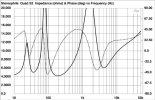Barrelhouse Solly
Senior Member
- Joined
- Aug 13, 2020
- Messages
- 379
- Likes
- 362
Loud and soft are quantifiable, although the boundaries are arbitrary. I imagine some of the other subjective terms could be quantified if there were a basic definition like "Blue is a range of light frequencies between X and Y."

